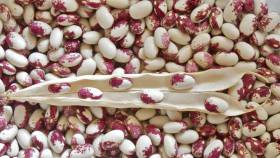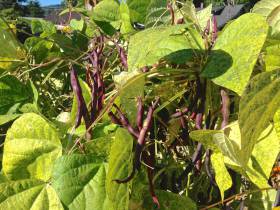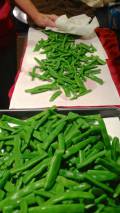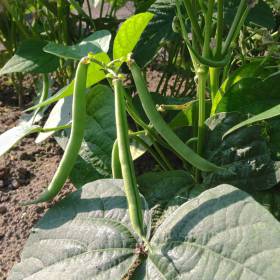Table of Contents
Varieties we have grown
Dry beans
My favorite are beans that dry out. These bean plants are adapted over decades to serve their purpose in so many ways. A fully adapted dry bean, in my book, has these properties:
- They grow quickly and stand upright.
- They flower, fix the load of beans and they stop flowering.
- They hold the beans up off the ground (so Fall rains won't soak the pods)
- They are easy to shell.
- They complete their cycle in less than 90 days.
The pod of a bean for drying is an engineering marvel. Somehow, each pod keeps out water, unless buried in wet soil. Some are “spring-loaded” so that as the pod dries it twists and eventually snaps open to reveal the beans. This last feature makes them easy to shell.
Varieties
Following are my favorites, the ones I will continue to plant because of their versatility, their vitality and their flavor.
 Rockwell is a local variety that began in the San Juan islands and has spread through the Pacific Northwest. The beans pre colorful and they cook well with excellent flavor. What I appreciate most is their “habit.” They germinate in cooler temperatures, they grow quickly and stand upright, they put on a load of beans and then they stop. By August the beans have dried out and the beans are almost jumping out of the pods. Rockwell doesn't do well as a green string bean because the shells are tough from the start, but that may make them the better as a dry bean.
Rockwell is a local variety that began in the San Juan islands and has spread through the Pacific Northwest. The beans pre colorful and they cook well with excellent flavor. What I appreciate most is their “habit.” They germinate in cooler temperatures, they grow quickly and stand upright, they put on a load of beans and then they stop. By August the beans have dried out and the beans are almost jumping out of the pods. Rockwell doesn't do well as a green string bean because the shells are tough from the start, but that may make them the better as a dry bean.
 Trail of Tears is a heritage variety known from the trials of the Cherokee Nation being relocated from their traditional lands to Tennessee. Tears takes longer to mature and dry out, but when the beans are green they make good snap beans. When they dry out the pods turn dark maroon or brown and the beans are black, the most healthy of beans. Their only disadvantage is that they take longer to dry out but they compensate for this by being a pole bean that has placed the pods up in the air, handing straight down so rain and moisture have less effect. Still a very wet September can reduce the harvest because of mildew. But their nutritional value makes them worth the wait and the effort.
Trail of Tears is a heritage variety known from the trials of the Cherokee Nation being relocated from their traditional lands to Tennessee. Tears takes longer to mature and dry out, but when the beans are green they make good snap beans. When they dry out the pods turn dark maroon or brown and the beans are black, the most healthy of beans. Their only disadvantage is that they take longer to dry out but they compensate for this by being a pole bean that has placed the pods up in the air, handing straight down so rain and moisture have less effect. Still a very wet September can reduce the harvest because of mildew. But their nutritional value makes them worth the wait and the effort.
 This heirloom was brought to Tennessee by the Cherokee people as they were marched from the Smokey Mountains of Oklahoma by the Federal Government in 1839 over the infamous “Trail of Tears” to Tennessee that left so many dead and suffering.
This heirloom was brought to Tennessee by the Cherokee people as they were marched from the Smokey Mountains of Oklahoma by the Federal Government in 1839 over the infamous “Trail of Tears” to Tennessee that left so many dead and suffering.
It's interesting to watch the colors of these beans change. First they are green, at which time they are great string beans. Then they mature to a maroon, and as they dry the color changes to tan. So it's easy to tell where they are in their process of maturing.
I find that these cook best after soaking all night and then slow cooking for 8 hours. Happily, they don't go mushy.
Snap beans
 We eat snap beans cooked or we freeze them for later.
We eat snap beans cooked or we freeze them for later.
 Provider is another heritage bean that generally does well. It is supposed to germinate well in cool soil - it seemed in 2014 that it didn't do as well planted late. Provider does provide lots of tasty green beans. In 2014 we had some challenges by planting them later than the previous year. Bugs or critters decimated the initial planting and damaged a number of plants. (We had a scourge of Cucumber Beetles this year that we didn't have previously. This was a lesson in timing - getting a crop to a mature state before seasonal bugs arrive. Applications of Neem Oil may have helped, but couldn't undo the earlier damage. Provider snap beans freeze well and have great flavor cooked fresh.
Provider is another heritage bean that generally does well. It is supposed to germinate well in cool soil - it seemed in 2014 that it didn't do as well planted late. Provider does provide lots of tasty green beans. In 2014 we had some challenges by planting them later than the previous year. Bugs or critters decimated the initial planting and damaged a number of plants. (We had a scourge of Cucumber Beetles this year that we didn't have previously. This was a lesson in timing - getting a crop to a mature state before seasonal bugs arrive. Applications of Neem Oil may have helped, but couldn't undo the earlier damage. Provider snap beans freeze well and have great flavor cooked fresh.
Provider doesn't dry down as quickly - it's not well adapted to this. The plants are predisposed to continue flowering and bearing so drying down takes longer than beans so adapted. But they do make good dry beans and a fine addition to a bean soup.
 Blue Lake is a standard, pole bean that I tried in 2014. It had a slow start, but has good tasting snap beans. It continues to bear through September.
Blue Lake is a standard, pole bean that I tried in 2014. It had a slow start, but has good tasting snap beans. It continues to bear through September.
I'll be drying some of these for seeds. But it won't be more than a few because these guys just hang on - keep bearing, and don't dry well on the vine. That's often the case with green beans that aren't selected for drying. It was mid-October before I could find pods that were drying out and still weeks more for those I picked to completely dry out. I put a lot of beans into the compost so I could prepare the soil and plant a cover crop.
Withner White Cornfield
This variety of pole bean is adapted to grow in a cornfield using the corn stalks as a trellis. We tried these in 2014, probably planting the beans too late to take advantage of the corn stalks. But the plants were prolific and the beans tasted great, so I planted more at the farm.
Germination was poor (20%) so I replanted and get a few plants later in the season. I believe the cause of the poor germination was that the effects of the decomposition of tillage radish plants inhibited germination. And, some insects, particularly cucumber beetles, love to snack on the seedlings. Now I put row cover over the area until the plants are established.
I began growing these because they are said to do well in shady areas - and direct sun is a premium here. A typical application is among corn stalks, which can form a trellis. The first year I tried this the bean vines overwhelmed the corn stalks. Harvesting both was difficult because of the “jungle” the bean vines made.
What makes Withner appealing is that they have excellent flavor and texture. So these are my favorite pole bean.
Hannan Popbean
Now for a not so favorite.
These garbanzos are a favorite of Carol Deppe so I tried them. If you read my definition of a bean for drying, you can guess what I didn’t like.
The ones we tried were the Hannan Popbean. I got them from Krista at Backyard Beans and Grains Project. Carol likes to put them in a hot skillet and watch them pop. Then she eats them like pop corn. We may never get to that test.
 Poor germination (50%) - same with a second planting. Plants droop and lay their produce on the ground. They took a long time to dry out. You can tell from the photo that everything but the corn had been cleared away and we were still waiting on the Popbeans to dry. The rains came and I pulled them and took them to a greenhouse. Still a lot never did dry out.
Poor germination (50%) - same with a second planting. Plants droop and lay their produce on the ground. They took a long time to dry out. You can tell from the photo that everything but the corn had been cleared away and we were still waiting on the Popbeans to dry. The rains came and I pulled them and took them to a greenhouse. Still a lot never did dry out.
But the last straw was shelling them. Only one or two to a pod, and lots of empty or bad. I shelled for hours and had about a pint. I still have a box of unshelled garbanzos and they may never be opened. I love dry beans, I even like shelling them sometimes. But this one isn’t on my seed list. The beans are very small, so I think it would take a lot to make anything.
I’m thinking there are some better garbanzos for growing, but I haven’t looked. Seems like I read most varieties don’t do well up here, but I could be mistaken.
